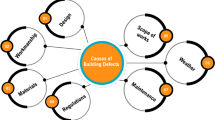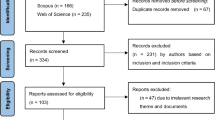Abstract
As buildings, age and natural deterioration occur, many types of defects are common and can be found in these buildings. Some of these defects can affect the security of building structures while most are local and non-structural. To address these issues, the study intends to identify how common is the common defects that typically happened. Using Quantitative Research Method to emphasize the objective measurements through the statistical, mathematical, or numerical analysis of the data collected through questionnaires online surveys. The finding shows how typical building defect can be so repetitively expected and common and this illustrates that perhaps effort to provide defects solution guide for the building construction players need to be stepped-up. One of the analytical variables; Concrete Flat Roof (CFR) affecting defect factor positively by letting the water to seep through its roof. Thus, this negative act impacting the interior space and qualitatively become the defects of most pertinent evidence. To conclude, there is a significant correlation between the selected building variables (for this case) and how they play the most typical defects role that indicates these evidence facts should come to grips with.
Access this chapter
Tax calculation will be finalised at checkout
Purchases are for personal use only
Similar content being viewed by others
References
Douglas EH, Ransom WH (2013) Understanding building failures (4th ed.). Retrieved from https://www.routledge.com/Understanding-Building-Failures-4th-Edition/Douglas-Ransom/p/book/9780415508797
Talib RB, Ahmad AG, Sulieman MZ (2015) Building design failure. Why did It fail? how it could have been avoided? Int J Chem Environ Biol Sci 3. Retrieved from http://www.isaet.org/images/extraimages/P815220.pdf
McKaig T (1962) Building failures—case studies in construction and design. Retrieved from https://books.google.com.my/books/about/Building_failures.html?id=4kFSAAAAMAAJ&redir_esc=y
Groat LN, Wang D (2002) Architectural research methods. Retrieved from https://elib.usm.my/cgi-bin/koha/opac-detail.pl?biblionumber=253605
Yeang K, RichardsI (2007) Eco skyscrapers. Retrieved from https://books.google.com.my/books?id=ivW3tgEACAAJ&dq=ken+yeang+eco+skyscrapers&hl=en&sa=X&ved=0ahUKEwiht_fDo8jiAhXBp48KHda0BmQQ6AEINDAB
Yusof MZ (2014) Understanding building failures and limit state design. Penerbit Univeristi Sains Malaysia, USM, Pulau Pinang
Kubba S (2008) Architectural forensics. McGraw-Hill
Noor Aziah MA, Mizanur RM, Nurul HS (2015) Methodologies in architectural research. Retrieved from http://www.mbpjlibrary.gov.my:8081/webopac/Record/0000197934
Wan Muhammad Amir WA, Nurfadhlina AH, Nor Azlida AM et al (2014) Data analysis using SPSS : version 22. Retrieved from https://books.google.com.my/books/about/Data_Analysis_Using_SPSS.html?id=UuJSAQAACAAJ&redir_esc=y
Wan Muhamad Amir WA, Nor Affendy NA, Ruhaya H (2017) Biostatistik Pelajari Kaedah Tak Berparameter Secara Mudah Menggunakan SPSS dan SAS. Retrieved from http://www.penerbit.usm.my/index.php/buku/174-teknik-biostatistik-pelajari-kaedah-tak-berparameter-secara-mudah-menggunakan-spss-dan-sas
Acknowledgements
I would like to express my deepest appreciation to all those who provided me with the possibility to complete this report. A special gratitude I give to my research supervisor, [Associate Professor Dr Sr M Zailan Sulieman], whose knowledge contribution and aspiring guidance, invaluably constructive criticism and friendly advice are invaluable. The publication of the paper is made possible through Universiti Sains Malaysia (USM)’s Research Grant Division (Grant No. 1001 PPBGN 8016034).
Author information
Authors and Affiliations
Corresponding author
Editor information
Editors and Affiliations
Rights and permissions
Copyright information
© 2021 The Author(s), under exclusive license to Springer Nature Singapore Pte Ltd.
About this paper
Cite this paper
Talib, R., Sulieman, M. (2021). Achieving Zero Defects Strategy: A Quantitative Report Adjudicating the Most Common Building Defects to Look Out for. In: Bin Meor Razali, A.M.M.F., Awang, M., Emamian, S.S. (eds) Advances in Civil Engineering Materials. Lecture Notes in Civil Engineering, vol 139. Springer, Singapore. https://doi.org/10.1007/978-981-33-6560-5_21
Download citation
DOI: https://doi.org/10.1007/978-981-33-6560-5_21
Published:
Publisher Name: Springer, Singapore
Print ISBN: 978-981-33-6559-9
Online ISBN: 978-981-33-6560-5
eBook Packages: EngineeringEngineering (R0)




